
Let us first glance over the extant facts.
Among the Stalk-eyed Crustacea (Podophthalma) we know only a very few species which quit the egg in the form of their parents, with the full number of well-jointed appendages to the body. This is the case according to Rathke1 in the European fresh-water Crayfish, and according to Westwood in a West Indian Land Crab (Gecarcinus). Both exceptions therefore belong to the small number of Stalk-eyed Crustacea which live in fresh water or on the land, as indeed in many other cases fresh-water and terrestrial animals undergo no transformations, whilst their allies in the sea have a metamorphosis to undergo. I may refer to the Earthworms and Leeches among the Annelida, which chiefly belong to the land and to fresh water,—to the Planariæ of the fresh waters and the Tetrastemma of the sparingly saline Baltic among the Turbellaria,—to the Pulmonate Gasteropoda, and to the Branchiferous Gasteropoda of the fresh waters, the young of which (according to Troschel’s ‘Handb. der Zoologie’) have no ciliated buccal lobes, although such organs are possessed by the very similar Periwinkles (Littorina).
All the marine forms of this section appear to be subject to a more or less considerable metamorphosis. This appears to be only inconsiderable in the common Lobster, the young of which, according to Van Beneden, are distinguished from the adult animal, by having their feet furnished, like those of Mysis, with a swimming branch projecting freely outwards. From a figure given by Couch the appendages of the abdomen and tail also appear to be wanting.
Far more profound is the difference of the youngest brood from the sexually mature animal in by far the greater majority of the Podophthalma, which quit the egg in the form of Zoëa. This young form occurs, so far as our present observations go, in all the Crabs, with the sole exception of the single species investigated by Westwood. I say species, and not genus, for in the same genus, Gecarcinus, Vaughan Thompson found Zoëa-brood,2 which is also met with in other terrestrial Crabs (Ocypoda, Gelasimus, etc.). All the Anomura seem likewise to commence their lives as Zoëæ: witness the Porcellanæ, the Tatuira (Hippa emerita) and the Hermit Crabs. Among the Macrura we are acquainted with the same earliest form principally in several Shrimps and Prawns, such as Crangon (Du Cane), Caridina (Joly), Hippolyte, Palæmon, Alpheus, etc. Lastly, it is not improbable, that the youngest brood of the Mantis-Shrimps (Squilla) is also in the same case.
The most important peculiarities which distinguish this Zoëa-brood from the adult animal, are as follows:—
The middle-body with its appendages, those five pairs of feet to which these animals owe their name of Decapoda, is either entirely wanting, or scarcely indicated; the abdomen and tail are destitute of appendages, and the latter consists of a single piece. The mandibles, as in the Insecta, have no palpi. The maxillipedes, of which the third pair is often still wanting, are not yet brought into the service of the mouth, but appear in the form of biramose natatory feet. Branchiæ are wanting, or where their first rudiments may be detected as small verruciform prominences, these are dense cell-masses, through which the blood does not yet flow, and which therefore have nothing to do with respiration. An interchange of the gases of the water and blood may occur all over the thin-skinned surface of the body; but the lateral parts of the carapace may unhesitatingly be indicated as the chief seat of respiration. They consist, exactly as described by Leydig in the Daphniæ, of an outer and inner lamina, the space between which is traversed by numerous transverse partitions dilated at their ends; the spaces between these partitions are penetrated by a more abundant flow of blood than occurs anywhere else in the body of the Zoëa. To this may be added that a constant current of fresh water passes beneath the carapace in a direction from behind forwards, maintained as in the adult animal, by a foliaceous or linguiform appendage of the second pair of maxillæ (Fig. 18). The addition of fine coloured particles to the water allows this current of water to be easily detected even in small Zoëæ.

Fig. 17. Zoëa of a Marsh Crab (Cyclograpsus
?), magnified.
Fig. 18. Maxilla of the second pair in the same species,
magnified.
The Zoëæ of the Crabs (Fig. 17) are usually distinguished by long, spiniform processes of the carapace. One of these projects upwards from the middle of the back, a second downwards from the forehead, and frequently there is a shorter one on each side near the posterior inferior angles of the carapace. All these processes are, however, wanting in Maia according to Couch, and in Eurynome according to Kinahan; and in a third species of the same group of the Oxyrhynchi (belonging or nearly allied to the genus Achæus) I also find only an inconsiderable dorsal spine, whilst the forehead and sides are unarmed. This is another example warning us to be cautious in deductions from analogy. Nothing seemed more probable than to refer back the beak-like formation of the forehead in the Oxyrhynchi to the frontal process of the Zoëa, and now it appears that the young of the Oxyrhynchi are really quite destitute of any such process. The following are more important peculiarities of the Zoëæ of the Crabs, although less striking than these processes of the carapace which, in combination with the large eyes, often give them so singular an appearance:—the anterior (inner) antennæ are simple, not jointed, and furnished at the extremity with from two to three olfactory filaments; the posterior (outer) antennæ frequently run out into a remarkably long spine-like process (“styliform process,” Spence Bate), and bear, on the outside, an appendage, which is sometimes very minute (“squamiform process” of Spence Bate), corresponding with the antennal scale of the Prawns,3 and the first rudiment of the future flagellum is often already recognisable. Of natatory feet (afterwards maxillipeds) only two pairs are present; the third (not, as Spence Bate thinks, the first) is entirely wanting, or, like the five following pairs of feet, present only as a minute bud. The tail, of very variable form, always bears three pairs of setæ at its hinder margin. The Zoëæ of the Crabs usually maintain themselves in the water in such a manner that the dorsal spine stands upwards, the abdomen is bent forwards, the inner branch of the natatory feet is directed forwards, and the outer one outwards and upwards.
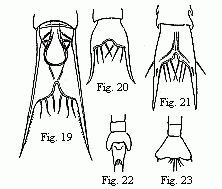
Figs. 19 to 23. Tails of the Zoëæ of
various Crabs.
Fig. 19. Pinnotheres. Fig. 20. Sesarma. Fig. 21.
Xantho.
Figs. 22 and 23 of unknown origin.
It is further to be remarked that the Zoëæ of the Crabs, as also of the Porcellanæ, of the Tatuira and of the Shrimps and Prawns, are enveloped, on escaping from the egg, by a membrane veiling the spinous processes of the carapace, the setæ of the feet, and the antennæ, and that they cast this in a few hours. In Achæus I have observed that the tail of this earliest larval skin resembles that of the larvæ of Shrimps and Prawns, and the same appears to be the case in Maia (see Bell, ‘Brit. Stalk-eyed Crust.’ p. 44). Widely as they seem to differ from them at the first glance, the Zoëæ of the Porcellanæ (Fig. 24) approach those of the true Crabs very closely. The antennæ, organs of the mouth, and natatory feet, exhibit the same structure. But the tail bears five pairs of setæ, and the dorsal spine is wanting, whilst, on the contrary, the frontal process and the lateral spines are of extraordinary length, and directed straight forward and backward.
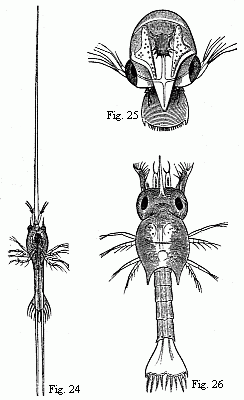
Fig. 24. Zoëa of Porcellana stellicola,
F. Müll., magnified.
Fig. 25. Zoëa of the Tatuira (Hippa emerita),
magnified.
Fig. 26. Zoëa of a small Hermit Crab, magnified.
The Zoëa of the Tatuira (Fig. 25) also appears to differ but little from those of the true Crabs, which it likewise resembles in its mode of locomotion. The carapace possesses only a short, broad frontal process; the posterior margin of the tail is edged with numerous short setæ.
The Zoëa of the Hermit Crabs (Fig. 26) possesses the simple inner antennæ of the Zoëa of the true Crabs; the outer antennæ bear upon the outside on a short stalk a lamella of considerable size analogous to the scale of the antennæ of the Prawns; on the inside, a short, spine-like process; and between the two the flagellum, still short, but already furnished with two apical setæ. As in the Crabs, there are only two pairs of well-developed natatory feet (maxillipedes), but the third pair is also present in the form of a two-jointed stump of considerable size, although still destitute of setæ. The tail bears five pairs of setæ. The little animal usually holds itself extended straight in the water, with the head directed downwards.
This is also the position in which we usually see the Zoëæ of the Shrimps and Prawns (Fig. 27), which agree in their general appearance with those of the Hermit Crabs. Between the large compound eyes there is in them a small median eye. The inner antennæ bear, at the end of a basal joint sometimes of considerable length, on the inside a plumose seta, which also occurs in the Hermit Crabs, and on the outside a short terminal joint with one or more olfactory filaments. The outer antennæ exhibit a well-developed and sometimes distinctly articulated scale, and within this usually a spiniform process; the flagellum appears generally to be still wanting. The third pair of maxillipedes seems to be always present, at least in the form of considerable rudiments. The spatuliform caudal lamina bears from five to six pairs of setæ on its hinder margin.
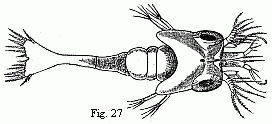
Fig. 27. Zoëa of a Palæmon residing upon Rhizostoma cruciatum, Less., magnified.
The development of the Zoëa-brood to the sexually mature animal was traced by Spence Bate in Carcinus mænas. He proved that the metamorphosis is a perfectly gradual one, and that no sharply separated stages of development, like the caterpillar and pupa of the Lepidoptera, could be defined in it. Unfortunately we possess only this single complete series of observations, and its results cannot be regarded at once as universally applicable; thus the young Hermit Crabs retain the general aspect and mode of locomotion of Zoëæ, whilst the rudiments of the thoracic and abdominal feet are growing, and then, when these come into action, appear at once in a perfectly new form, which differs from that of the adult animal chiefly by the complete symmetry of the body and by the presence of four pairs of well-developed natatory feet on the abdomen.4
The development of the Palinuridiæ seems to be very peculiar. Claus found in the ova of the Spiny Lobster (Palinurus), embryos with a completely segmented body, but wanting the appendages of the tail, abdomen, and last two segments of the middle-body; they possess a single median and considerably compound eye; the anterior antennæ are simple, the posterior furnished with a small secondary branch; the mandibles have no palpi; the maxillipedes of the third pair, like the two following pairs of feet, are divided into two branches of nearly equal length; whilst the last of the existing pairs of feet and the second pair of maxillipedes bear only an inconsiderable secondary branch. Coste, as is well known, asserts that he has bred young Phyllosomata from the ova of this lobster—a statement that requires further proof, especially as the more recent investigations of Claus upon Phyllosoma by no means appear to be in its favour.
The large compound eyes, which usually soon become moveable, and sometimes stand upon long stalks even in the earliest period, as well as the carapace, which covers the entire fore-body, indicate at once that the position of the larvæ hitherto considered, notwithstanding all their differences, is under the Podophthalma. But not a single characteristic of this section is retained by the brood of some Prawns belonging to the genus Penëus or in its vicinity. These quit the egg with an unsegmented ovate body, a median frontal eye, and three pairs of natatory feet, of which the anterior are simple, and the other two biramose—in fact, in the larval form, so common among the lower Crustacea, to which O. F. Müller gave the name of Nauplius. No trace of a carapace! no trace of the paired eyes! no trace of masticating organs near the mouth which is overarched by a helmet-like hood!
In the case of one of these species the intermediate forms which lead from the Nauplius to the Prawn, have been discovered in a nearly continuous series.
The youngest Nauplius (Fig. 28) is immediately followed by forms in which a fold of skin runs across the back behind the third pair of feet, and four pairs of stout processes (rudiments of new limbs) sprout forth on the ventral surface. Within the third pair of feet, powerful mandibles are developed.
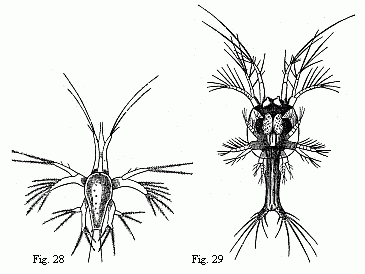
Fig. 28. Nauplius of a Prawn, magnified.
Fig. 29. Young Zoëa of the same Prawn, magnified.
In a subsequent moult the new limbs (maxillæ, and anterior and intermediate maxillipedes) come into action, and in this way the Nauplius becomes a Zoëa (Fig. 29), agreeing perfectly with the Zoëa of the Crabs in the number of the appendages of the body, although very different in form and mode of locomotion and even in many particulars of internal structure. The chief organs of motion are still the two anterior pairs of feet, which are slender and furnished with long setæ; the third pair of feet loses its branches, and becomes converted into mandibles destitute of palpi. The labrum acquires a spine directed forward and of considerable size, which occurs in all the Zoëæ of allied species. The biramose maxillipedes appear to assist but slightly in locomotion. The forked tail reminds us rather of the forms occurring in the lower Crustacea, especially the Copepoda, than of the spatuliform caudal plate which characterises the Zoëæ of Alpheus, Palæmon, Hippolyte, and other Prawns, of the Hermit Crabs, the Tatuira and the Porcellanæ. The heart possesses only one pair of fissures, and has no muscles traversing its interior like trabeculæ, whilst in other Zoëæ two pairs of fissures and an interior apparatus of trabeculæ are always distinctly recognisable.
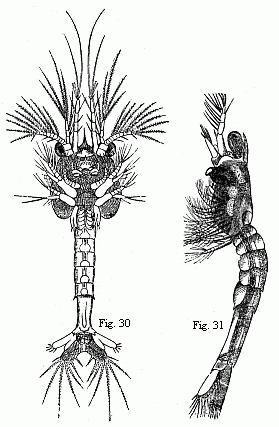
Fig. 30. Older Zoëa of the same Prawn,
magnified.
Fig. 31. Mysis-form of the same Prawn, magnified.
During this Zoëal period the paired eyes, the segments of the middle-body and abdomen, the posterior maxillipedes, the lateral caudal appendages and the stump-like rudiments of the feet of the middle-body are formed (Fig. 30). The caudal appendages sprout forth like other limbs freely on the ventral surface, whilst in other Prawns, the Porcellanæ, etc., they are produced in the interior of the spatuliform caudal plate.
As the feet of the middle-body come into action, simultaneously with other profound changes, the Zoëa passes into the Mysis- or Schizopod-form (Fig. 31). The antennæ cease to serve for locomotion, their place is taken by the thoracic feet, furnished with long setæ, and by the long abdomen which just before was laboriously dragged along as a useless burden, but now, with its powerful muscles, jerks the animal through the water in a series of lively jumps. The anterior antennæ have lost their long setæ, and by the side of the last (fourth) joint, endowed with olfactory filaments, there appears a second branch, which is at first of a single joint. The previously multi-articulate outer branch of the posterior antennæ has become a simple lamella, the antennal scale of the Prawn; beside this appears the stump-like rudiment of the flagellum, probably as a new formation, the inner branch disappearing entirely. The five new pairs of feet are biramose, the inner branch short and simple, the outer one longer, annulated at the end, furnished with long setæ, and kept, as in Mysis, in constant whirling motion. The heart acquires new fissures, and interior muscular trabeculæ.
During the Mysis-period, the auditory organs in the basal joint of the anterior antennæ are formed; the inner branches of the first three pairs of feet are developed into chelæ and the two hinder pairs into ambulatory feet; palpi sprout from the mandibles, branchiæ on the thorax, and natatory feet on the abdomen. The spine on the labrum becomes reduced in size. In this way the animal gradually approaches the Prawn-form, in which the median eye has become indistinct, the spine of the labrum, and the outer branches of the cheliferous and ambulatory feet have been lost, the mandibular palpi and the abdominal feet have acquired distinct joints and setæ, and the branchiæ come into action.
In another Prawn, the various larval states of which may be easily recognised as belonging to the same series by the presence of a dark-yellow, sharply-defined spot surrounding the median eye, the youngest Zoëa (Fig. 32), probably produced from the Nauplius, agrees in all essential particulars with the species just described; its further development is, however, very different, especially in that neither the feet of the middle, nor those of the hind-body are formed simultaneously, and that a stage of development comparable to Mysis in the number and structure of the limbs does not occur.
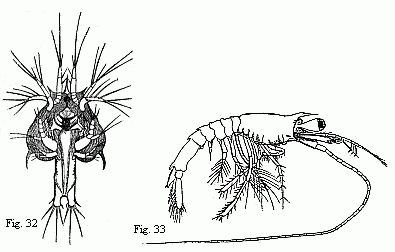
Fig. 32. Youngest (observed) Zoëa of another
Prawn. The minute buds of the third pair of maxillipedes are
visible. The formation of the abdominal segments has commenced.
Paired eyes still wanting. Magnified.
Fig. 33. Older larva produced from the Zoëa represented in
Fig. 32. The last segment and the last two pairs of feet of the
middle-body are wanting. Magnified.
Traces of the outer maxillipedes make their appearance betimes. Then feet appear upon four segments of the middle-body, and these are biramose on the three anterior segments, and simple, the inner branch being deficient, on the fourth segment. On the inner branches the chelæ are developed; the outer branches are lost before an inner branch has made its appearance on the fourth segment (Fig. 32). The latter again becomes destitute of appendages, so that in this case at an early period four, and at a later only three, segments of the middle-body bear limbs. The fifth segment is still entirely wanting, whilst all the abdominal segments have also acquired limbs, and this one after the other, from before backwards. The adult animal, as shown by the three pairs of chelæ, will certainly be very nearly allied to the preceding species.5
The youngest larva of the Schizopod genus Euphausia observed by Claus, stands very near the youngest Zoëa of our Prawns; but whilst its anterior antennæ are already biramose, and it therefore appears to be more advanced, it still wants the middle maxillipedes. In it also Claus found the heart furnished with only a single pair of fissures. Do not Nauplius-like states in this case also precede the Zoëa?
The developmental history of Mysis, the near relationship of which with the Shrimps and Prawns has recently again been generally recognised, has been described in detail by Van Beneden. So far as I have tested them I can only confirm his statements. The development of the embryo commences with the formation of the tail! This makes its appearance as a simple lobe, the dorsal surface of which is turned towards and closely applied to that of the embryo. (The young of other Stalk-eyed Crustacea are, as is well known, bent in the egg in such a manner that the ventral surfaces of the anterior and posterior halves of the body are turned towards each other,—in these, therefore, the dorsal, and in Mysis the ventral surface appears convex.) The tail soon acquires the furcate form with which we made acquaintance in the last Prawn-Zoëa described. Then two pairs of thick ensiform appendages make their appearance at the opposite end of the body, and behind these a pair of tubercles which are easily overlooked. These are the antennæ and mandibles. The egg-membrane now bursts, before any internal organ, or even any tissue, except the cells of the cutaneous layer, is formed. The young animal might be called a Nauplius; but essentially there is nothing but a rough copy of a Nauplius-skin, almost like a new egg-membrane, within which the Mysis is developed. The ten pairs of appendages of the fore- (maxillæ, maxillipedes) and middle-body make their appearance simultaneously, as do the five pairs of abdominal feet at a later period. Soon after the young Mysis casts the Nauplius-envelope it quits the brood-pouch of the mother.6
For some time, owing to an undue importance being ascribed to the want of a particular branchial cavity, Mysis, Leucifer, and Phyllosoma were referred to the Stomapoda, which are now again limited, as originally by Latreille, to the Mantis-shrimps (Squilla), the Glass-shrimps (Erichthus) and their nearest allies. Of the developmental history of these we have hitherto been acquainted with only isolated fragments. The tracing of the development in the egg is rendered difficult by the circumstance, that the Mantis-shrimps do not, like the Decapoda, carry their spawn about with them, but deposit it in the subterranean passages inhabited by them in the form of thin, round, yellow plates. The spawn is consequently exceedingly difficult to procure, and unfortunately it becomes spoilt in a day when it is removed from its natural hatching place, whilst on the contrary the progress of development may be followed for weeks together in the eggs of a single Crab kept in confinement. The eggs of Squilla, like those removed from the body of the Crab, die because they are deprived of the rapid stream of fresh water which the mother drives through her hole for the purpose of her own respiration.
The accompanying representation of the embryo of Squilla shows that it possesses a long, segmented abdomen without appendages, a bilobate tail, six pairs of limbs, and a short heart; the latter only pulsates weakly and slowly. If it acquires more limbs before exclusion, the youngest larva must stand on the same level as the youngest larva of Euphausia observed by Claus.
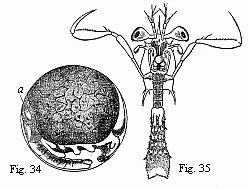
Fig. 34. Embryo of a Squilla, magnified. a.
heart.
Fig. 35. Older larva (Zoëa) of a Stomapod, magnified.
Of the two larval forms at present known which are with certainty to be ascribed, if not to Squilla, at least to a Stomapod, I pass over the younger one7 as its limbs cannot be positively interpreted, and will only mention that in it the last three abdominal segments are still destitute of appendages. The older larva (Fig. 35), which resembles the mature Squilla especially in the structure of the great raptorial feet and of the preceding pair, still wants the six pairs of feet following the raptorial feet. The corresponding body-segments are already well developed, an unpaired eye is still present, the anterior antennæ are already biramose, whilst the flagellum is wanting in the posterior, and the mandibles are destitute of palpi; the four anterior abdominal segments bear biramose natatory feet, without branchiæ; the fifth abdominal segment has no appendages, and this is also the case with the tail, which still appears as a simple lamina, fringed on the hinder margin with numerous short teeth. It is evident that the larva stands essentially in the grade of Zoëa.
1. Authorities are cited only for
facts which I have had no opportunity of confirming.
2. Bell (‘Brit. Stalk-eyed Crust.’ p.
xlv) considers himself justified in “eliminating”
Thompson’s observation at once, because he could only have
examined ovigerous females preserved in alcohol. But any one who
had paid so much attention as Thompson to the development of these
animals, must have been well able to decide with certainty upon
eggs, if not too far from maturity or badly preserved, whether a
Zoëa would be produced from them. Moreover, the mode of life
of the Land-Crabs is in favour of Thompson. “Once in the
year,” says Troschel’s ‘Handbuch der
Zoologie,’ “they migrate in great crowds to the sea in
order to deposit their eggs, and afterwards return much exhausted
towards their dwelling places, which are reached only by a
few.” For what purpose would be these destructive migrations
in species whose young quit the egg and the mother as terrestrial
animals?
3. In a memoir on the metamorphoses of the
Porcellanæ I have erroneously described this appendage as the
“flagellum.”
4. Glaucothoë Peronii, M.-Edw., may
be a young and still symmetrical Pagurus of this kind.
5. The oldest observed larvæ (see Fig. 33)
are characterised by the extraordinary length of the flagella of
the outer antennæ, and in this respect resemble the larva of
Sergestes found by Claus near Messina (Zeitschr. für
Wiss. Zool. Bd. xiii. Taf. 27, Fig. 14). This unusual length of the
antennæ leads to the supposition that they belong to our
commonest Prawn, which is very frequently eaten, and is most nearly
allied to Penëus setiferus of Florida. Claus’s
Acanthosoma (l. c. Fig. 13) is like the younger
Mysis-form of the larva figured by me in the ‘Archiv
für Naturgeschichte,’ 1836, Taf. 2, Fig. 18, and which I
am inclined to refer to Sicyonia carinata.
6. Van Beneden, who regards the eye-peduncles as
limbs, cannot however avoid remarking upon Mysis: “Ce
pédicule n’apparaît aucunement comme les autres
appendices, et paraît avoir une autre valeur
morphologique.”
7. ‘Archiv für Naturgeschichte’
1863. Taf. 1.